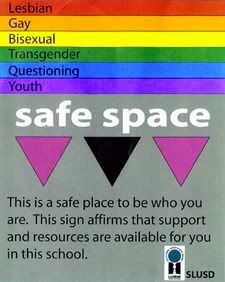 The pictured poster was designed by the Bay Area’s San Leandro High School Gay-Straight Alliance as part of an effort to comply with state laws “requiring schools to ensure students' safety and curb discrimination and harassment.” In December, the school board approved a policy which requires all teachers in the district to hang the posters in their classrooms, but, the San Francisco Chronicle reports that five teachers are refusing to display the posters in their classrooms because “homosexuality violates their religious beliefs.”
The pictured poster was designed by the Bay Area’s San Leandro High School Gay-Straight Alliance as part of an effort to comply with state laws “requiring schools to ensure students' safety and curb discrimination and harassment.” In December, the school board approved a policy which requires all teachers in the district to hang the posters in their classrooms, but, the San Francisco Chronicle reports that five teachers are refusing to display the posters in their classrooms because “homosexuality violates their religious beliefs.”Lots of things in public schools violate someone’s religious beliefs. But, much like pharmacists who choose a profession in which they may be required to dispense medications they may personally not like, professional public school educators must respect that many of their students’ personal beliefs and traits will be different from their own. That’s why Pentecostal public school educators can’t require their female students to not cut their hair and wear only ankle-length skirts, and Jewish public school educators can’t demand that their male students all wear yarmulkes, and atheist public school educators can’t forbid crucifixes and yarmulkes and hajibs. It simply isn’t the job of public school educators to dictate their own religious beliefs (or lack thereof) to their students.
And, as an aside, even if homosexuality does violate one’s religious beliefs, respect for and protection of homosexuals does not.
Take a look at that poster. This is a safe space to be who you are. Why is it even necessary? In 2001, the Sexuality Information and Education Council of the United States (SIECUS) surveyed lesbian, gay, bisexual, transgender, and questioning (LGBTQ) students under 19 years of age nationwide, and found (in part):
69% of LGBTQ youth reported experiencing some form of harassment or violence. 61.1% of LGBTQ youth reported experiences of verbal harassment with 45.9% having experienced it daily. 46.5% reported experiences of sexual harassment, 27.6% reported experiences of physical harassment, and 13.7% reported experiences of physical assaultNearly 14% of LGBYQ youth have been physically assaulted at school, and these so-called Christians are more interested in taking a stand against hanging a poster reassuring them that they’re safe than actually making sure they’re safe. They’d rather make political points about how persecuted poor Christians on government wages are than be a part of productively addressing the actual, physical persecution of gay teens.
~ 99.4% of LGBTQ youth reported hearing homophobic remarks from other studentsMy parents were both public high school teachers and are both devout, practicing Christians whose lives revolve around their church, and neither one of them felt the least conflict of interest in making sure their gay students were protected and treated with respect. If my mother heard one of her students even use “gay” as a negative term—“This homework assignment is gay”—she would chastise them for it, no less if they were actually harassing a gay student. And far from considering that in violation of her religious beliefs, she felt it was a necessary application of them, not to mention one of her prerogatives as a teacher.
~ 36.6% of LGBTQ youth reported hearing homophobic remarks from faculty or school staff
~ 39.2% of LGBTQ youth reported that no one ever intervened when homophobic remarks were heard. 46.5% reported that someone intervened only some of the time. Other students were more often reported to intervene (82.4%) than were faculty (66.5%)
If homosexuality violates your religious beliefs, fine—don’t be gay. But don’t pretend it gives you the right as a public educator to refuse to protect your gay students.
I’d have loved to hear the explanation from these five homobigots where in their scripture it tells them that protecting homosexuals from harassment is against God’s will, but, of course, these brave Christian soldiers weren’t available for comment.
(Hat tip to Catherine.)




Shakesville is run as a safe space. First-time commenters: Please read Shakesville's Commenting Policy and Feminism 101 Section before commenting. We also do lots of in-thread moderation, so we ask that everyone read the entirety of any thread before commenting, to ensure compliance with any in-thread moderation. Thank you.
blog comments powered by Disqus